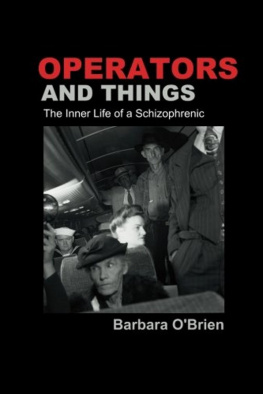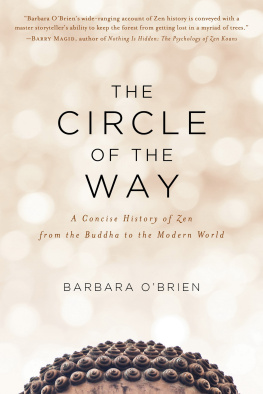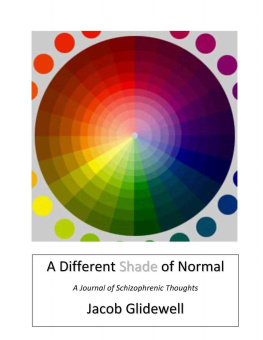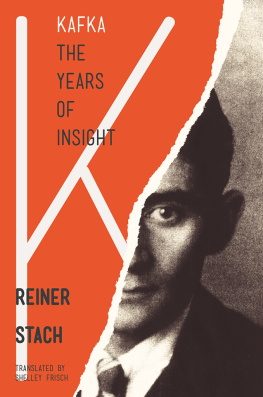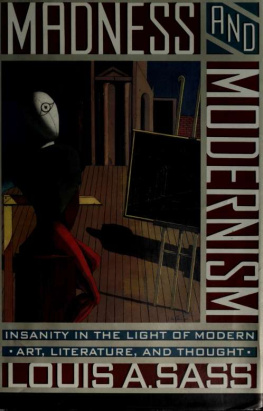Operators and Things:
The Inner Life of a Schizophrenic
Barbara OBrien
Smashwords Edition
Copyright 1958 Barbara OBrien
Introduction
Everything about this psychology is, in the deepest sense, experience; C.G. Jung has written, the entire theory, even when it puts on its most abstract airs, is the direct outcome of something experienced. Jung also writes To experience a dream and its interpretation is very different from having a tepid rehash set before you on paper. [C.G. Jung, Two Essays on Analytical Psychology , New York: Meridian, 1956. Page 127. The essay, General Remarks on the Therapeutic Approach to the Unconscious, of which this quotation is a part, is particularly relevant to Barbaras account of her hallucinations. Jung, much more so than Freud, is aware of the healing and creative as well as the destructive elements in the unconscious.]
This book is one persons experience of living a dream which does not fit easily into abstract theory, even the authors own. As she tells us, the dry beach of the conscious mind is a poor relation to the unconscious. Although we speak a common conscious language, socialized by our common culture, it is no easy thing for a man to communicate with even his own unconscious. For psychology, everyones experience must be relevant; the experts in this field depend on the experience of others. Theory is little more than an organizing myth, and myths become powerful theories only by remaining sensitive to experience.
Ideally, we would like to be able to apply the content of Barbaras schizophrenic world to some myth or model, no matter how inadequate, of the unconscious processes. In this connection, two points made by Barbara are particularly interesting to me. The first is her feeling that the drama staged by her unconscious was an attempt to save her from the unbearable, an idea that supports Freuds hypothesis that the hallucinatory (hysterical) mechanism is an attempt at recovery, not the disease itself. [Sigmund Freud, On the Mechanism of Paranoia, in Collected Papers Volume III , London: The Hogarth Press, 1925 Pages 444-470. In fact, Freud credits the idea of hallucinations as attempts at recovery to Jungs observations that the flight of ideas and motor stereotypes occurring in this disorder (dementia praecox or paraphrenia) are the relics of former object-cathexes, clung to with convulsive energy. Barbara places herself in the diagnostic category of paranoia. It is probably more correct to call her illness paraphrenia , which, as Freud points out, is close to paranoia and can develop from it. The differences are described briefly in the above paper. This paper is worth reading from another angle, also. Barbaras description of the cure offered by the psychoanalyst she saw is quite different from Freuds theories about paraphrenia and its aeteosis, which he considers less sexual in the normal sense, more related to early infant problems which might better be called problems of trust and autonomy.] Barbaras hallucinations are not, however, the gods and devils common to another age; they are horrors of Organization Man; they are reactions to forces blocking attempts at creativity in work and attempts to enjoy relationships of trust with others.
Those who are creative in Barbaras world are impaled by the hook and those who trust are removed. For most of us, these problems of creativity and intimacy are the difference between a meaningful and satisfying life as opposed to a life of quiet: desperation. To Barbara, they are matters of staying alive, and this is perhaps as good a way as any to state simply the difference between the meaning of a problem to a normal person and to a schizophrenic. As Barbara admits honestly, her problems are not solved; she cannot claim a complete cure. The hallucinations are gone and her conscious mind can hold down a job; but the hook operators are still, unbearable, and there is no indication that she can trust enough to enjoy human contact.
In fact, she tells little of her feelings about the people who are and were significant in her life. The only interactions we witness (other than in her hallucinatory dramas) are her contacts with a busy, uncaring psychiatrist and with a caricature of an orthodox psychoanalyst, who seems alternately amazed at Barbaras unconscious (understandably so) and intrigued by her femininity (a Frenchman, he suggests bed with an experienced European lover as a cure, an idea that Barbara wisely considers would create, for her, more problems than it would solve). For Barbara, the world remains hostile; survival is the central problem. The only optimistic elements in the story are Barbaras considerable intelligence and the creative urge which led to her novel and to this book.
Psychology does not know much about creativity. Freud analyzes Dostoevsky as a neurotic, but he admits: Before the problem of the creative artist analysis must, alas, lay down its arms. [Sigmund Freud, Dostoevsky and Parricide, in Collected Papers. Volume V , London: Hogarth Press, 1950.] In a similar way, one can explain William Blakes hallucinations and his denunciations of the Royal Academys Hook Operators, but the music of Blakes words, the form of their content, and the fact of creativity, rather than stagnation, remain an awesome mystery. Barbara writes and she writes well; creativity is a therapy by which Barbara transcends the psychiatrists work-a-day world of confessions and standardized inkblots. She imposes regularity and form over chaos, socializing the unconscious language in a way only the best therapies ever approach. Yet, as I have said, there is a great distance between bare survival and a satisfying life.
Barbara gives us another idea which has to do with some of the most interesting research into the connection between mental illness and physiological imbalance. She feels that her unconscious presented her with a drama with at least one moral to it: get your adrenal working, get angry or you will destroy yourself. Recent research indicates that depressive psychotics and some schizophrenics (indeed some normal-neurotics) who react to stress with fear show a different physiological pattern to stress than do those who react with anger or cunning. For example, those who fear (the anger-in people as Funkenstein [D. H. Funkenstein, S. H. King and M. E. Drolette, Mastery of Stress , Cambridge: Harvard University Press, 1957.] calls them) secrete less noradrenalin. Perhaps the anger-in people fear the feeling of anger itself more than they fear retaliation by real others. Perhaps the reaction of fear is a physiological poison which threatens a persons life. Perhaps only a psychological change, a willingness to be angry, can support a physiological reorganization. It is also possible that the fear of being angry spreads to become the fear of doing anything active which becomes the wish to crawl into a hole. Barbaras mad dash across the country seems to me like a first step toward curative activity as well as the abandonment of an environment from which her mind has already fled.
If the reader shares my curiosity, he or she will have the wish to know more about Barbara. What does she look like? What was her childhood like? What is she doing now? What kind of people have been important to her, other than people in authority? All we know is that she is a creative and independent woman, with intelligence, a strong sense of morality, and a talent for playfulness. Her playfulness and humor is to me Barbaras most impressive quality. Faced with a matter of life and death which lasted not for a moment but for months, her unconscious produced, along with Kafka-esque judges and Edward G. Robinson-type gangsters, characters like Nicky who are warm and playful. This book itself has an element of a Hollywood script, but a script which illustrates mans most endearing quality, the ability to translate the dangers within him, the fears about good and evil, into an external drama with heroes and villains, with pathos and humor. [For a discussion of the value of mans playfulness and his ability to reflect fearlessly on the strange customs and institutions by which... (he) must find self-realization, see Erik H. Erikson, Childhood and Society , New York: W. W. Norton and Co., 1950, particularly the chapter The Fear of Anxiety. One of Eriksons observations helps me to understand Barbaras case in a way different from the approach taken by Barbara herself. Barbara reports that her greatest fear from the operators is that of being dummetized, being made empty. And she finally believes that this has happened. Erikson writes: The fear of being left empty, and, more simply, that of being left , seems to be the most basic feminine fear, extending over the whole of a womans existence. It is normally intensified with every menstruation and takes its final toll during the menopause. No wonder, then, that the anxiety aroused by these fears can express itself either in complete subjugation to male thought, in desperate competition with it, or in efforts to catch the male and make him a mere tool. Page 366.] Psychology, if it is to be science rather than dogma, must learn from people like Barbara that the unconscious is not at all like the mechanized models of human behavior upon which we depend all too much.

